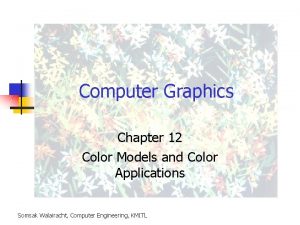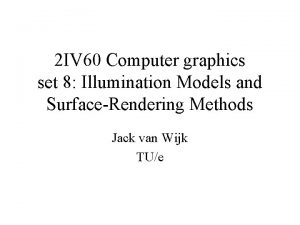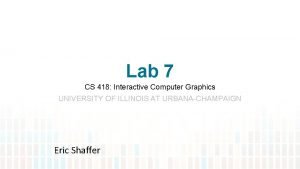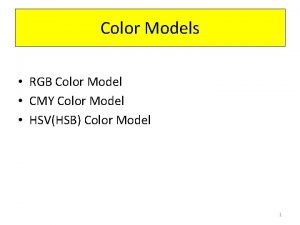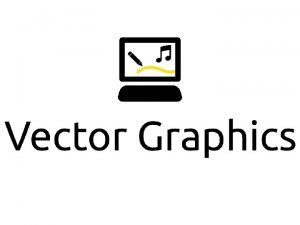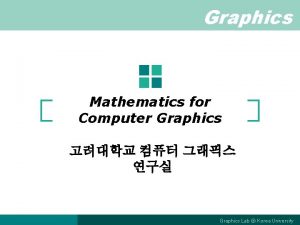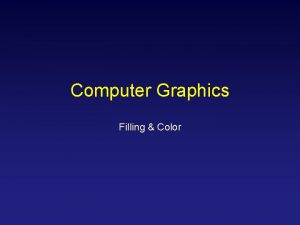Computer graphics Color Model 1 What is COLOR






















- Slides: 22

Computer graphics Color Model 1

What is COLOR? It is an attribute of objects (like texture, shape, smoothness, etc. ) It depends on: 1) spectral characteristics of the light source(s) (e. g. , sunlight) illuminating the objects (relative spectral power distribution(s) SPD) 2) spectral properties of objects (reflectance) 3) spectral characteristics of the sensors of the imaging device (e. g. , the human eye or a digital camera) 2

Primary and Secondary Color Due to the different absorption curves of the cones, colors are seen as variable combinations of the so-called primary colors: red, green, and blue Their wavelengths were standardized by the CIE in 1931: red=700 nm, green=546. 1 nm, and blue=435. 8 nm The primary colors can be added to produce the secondary colors of light, magenta (R+B), cyan (G+B), and yellow (R+G) 3

Color Model �A color model is an abstract mathematical model describing the way colors can be represented as tupples of numbers, typically as three or four values or color components. � Any method for explaining or behavior of color within some particular context is called a color model. 4

Color Model Shades, tints & tones *A shade is produced by “dimming” a hue. [adding black]. - Dark blue = pure blue + black. *A tint is produced by “lightening” a hue. [adding white]. -Pastel red = pure red + white. *Tone refers to the effects or reducing the “colorfulness” of a hue. [adding gray] or [adding black & white]. 5

Different Color Models o o o RGB (Red, Green, Blue) CMY (Cyan, Magenta, Yellow) HSI (Hue, Saturation, Intensity) YIQ (Luminance, In phase, Quadrature) YUV (Y' stands for the luma component (the brightness) and V are the chrominance (color) components ) and U 6

Properties of light � When white light is incident on an opaque object, some frequencies are reflected and some are absorbed. � The combination of frequencies present in the reflected light determines the color of the object that we see. 7

RGB Model In this model, the primary colors are red, green, and blue. It is an additive model, in which colors are produced by adding components, with white having all colors present and black being the absence of any color. This is the model used for active displays such as television and computer screens. The RGB model is usually represented by a unit cube with one corner located at the origin of a three-dimensional color coordinate system, the axes being labeled R, G, B, and having a range of values [0, 1]. The origin (0, 0, 0) is considered black and the diagonally opposite corner (1, 1, 1) is called white. The line joining black to white represents a gray scale and has equal components of R, G, B. 8

RGB Model Each color is represented in its primary color components Red, Green and Blue This model is based on Cartesian System Coordinate 9

RGB color system � Additive color model. � For computer display. � Uses light to display color. � Colors result from transmitted light. � Red + Green + Blue = White. 10

RGB color system � This model is called additive, and the colors are called primary colors. � The primary colors can be added to produce the secondary colors of light. Magenta(Red + Blue), Cyan(Green + Blue), and Yellow(Red + Green). The combination of Red, Green and Blue at full intensities makes white. 11

RGB color system � The combination of Red, Green and Blue in full intensity makes white. � White light is created when all color of the EM spectrum (electromagnetic spectrum) converge in full intensity. 12

Importance of RGB color model � The color model RGB is used in hardware applications like PC monitors, cameras and scanners. � It is used for Web graphics, but it cannot be used for print production. � It directly reflects the physical properties of “True-color” displays. 13

Importance of RGB color model � It is used— � For sensory representation. � Display of text images in electronic system, For example- computer, TV, camera. 14

Why RGB is better � In spite of this bias, however, RGB is really a better way to go for many reasons. Conversion from one color space to another can sometimes be problematic for companies that have a limited knowledge of color management. But in this time of automated color-managed workflows, the resistance to RGB makes little sense from a production point of view. And the pros of RGB generally are stronger than the cons. 15

Why RGB is better � The most compelling reason to adopt an RGB workflow is to increase the print provider’s ability to "match the original"-the RGB color space simply allows for a wider range of colors. While it’s true that no output device can match the color range of a transparency or digital camera, modern wide-format devices offer a much wider color gamut than traditional offset presses. In many cases, it makes perfect sense for each print job to try to get the maximum color space your device is capable of reproducing. Clearly, the more data you input to the device, the more you can output. 16

Why RGB is better � CMYK conversion, by definition, reduces the data contained in the original RGB image. And data that is thrown away can never be reclaimed-it’s gone for good. To retain as much data as possible, there is a growing trend toward performing color conversion only in the final rasterizetion process before printing. That way, all of the data in the image file is retained. 17

Cmyk color model � CMYK (subtractive color model) is the standard color model used in offset printing for full-color documents. Because such printing uses inks of these four basic colors, it is often called four-color printing. * A greenish blue called Cyan. • A blushed red called Magenta. • A bright Yellow. • The key color Black 18

Cmyk color model system � Subtractive color model. � For printed material. � Uses ink to display color. � Colors result from reflected light. � Cyan + Magenta + Yellow = Black. 19

Importance of cymk color model � The CMY color model is used in color printers. � It is created by the subtractive mode � Used in most commercial color printing (Books, Magazines etc. ). 20

Advantages of CMYK technique 1) Less color process / screen for print. 2) More productivity. 3) Cost minimizing. 4) Good hand feel because of using less color on ground. 5) CMYK color can be used for different item of print because of common color way. 21

Thanks to all 22
 Most of the graphics monitors today operate as
Most of the graphics monitors today operate as Computer graphics introduction ppt
Computer graphics introduction ppt Hsv in computer graphics
Hsv in computer graphics Synthetic camera model in computer graphics
Synthetic camera model in computer graphics Basic illumination models
Basic illumination models Angel computer graphics
Angel computer graphics Projection types in computer graphics
Projection types in computer graphics What is video display devices in computer graphics
What is video display devices in computer graphics Two dimensional viewing
Two dimensional viewing Shear transformation in computer graphics
Shear transformation in computer graphics Shader computer graphics
Shader computer graphics What is the basis of scan conversion of a circle
What is the basis of scan conversion of a circle Computer graphics
Computer graphics Region filling process has application in
Region filling process has application in Advantages and disadvantages of scan line fill algorithm
Advantages and disadvantages of scan line fill algorithm Polygon filling algorithm
Polygon filling algorithm Raster scan display advantages and disadvantages
Raster scan display advantages and disadvantages Computer graphics
Computer graphics Line drawing in computer graphics
Line drawing in computer graphics Cs 418 interactive computer graphics
Cs 418 interactive computer graphics Glcreatebuffer
Glcreatebuffer Depth sorting method in computer graphics
Depth sorting method in computer graphics Achromatic light in computer graphics
Achromatic light in computer graphics


